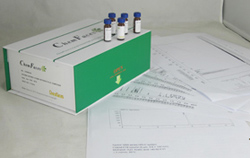Hot Products



| Catalog No. | Information |
| CFN91894 | Plantagoside Plantagoside is a potent inhibitor of the Maillard reaction, it also can inhibit the formation of advanced glycation end products in proteins in physiological conditions and inhibit protein cross-linking glycation. It is also a specific non-competitive inhibitor for jack bean alpha-mannosidase (IC50 at 5 microM). Plantagoside suppresses antibody response to sheep red blood cells and concanavalin A induced lymphocyte proliferation which was measured by [3H]thymidine incorporation. Plantagoside has potential therapeutic applications in the prevention of diabetic complications. |
| CFN93188 | Plantainoside D Plantainoside D shows potent antioxidative effects as those of ascorbic acid, it shows angiotensin-converting enzyme (ACE) inhibitory inhibitory activity in vitro with the IC(50) value of 2.17 mM, it also shows inhibitory activity against PKCalpha with the IC50 value (in microM) of 14.8. Plantainoside D protects adriamycin-induced apoptosis in H9c2 cardiac muscle cells via the inhibition of ROS generation and NF-kappaB activation. |
| CFN99522 | Plantamajoside Plantamajoside has antibacterial, antioxidant, anti-tumor, anti-inflammatory and anti-skin photoaging effects, it has protective activities against Cadmium-induced renal injury. Plantamajoside ameliorates lipopolysaccharide-induced acute lung injury via suppressing NF-κB and MAPK activation, it can inhibit UVB and advanced glycation end products‐induced MMP-1 Expression by suppressing the MAPK and NF‐ĸB pathways in HaCaT cells, and attenuate the upregulation of receptor for AGEs (RAGE) by glycer-AGEs with UVB irradiation. |
| CFN96496 | Plathymenin Plathymenin is a natural product from Spatholobus suberectus. |
| CFN92207 | Platycodigenin Platycodigenin has in vitro anti-proliferative activity against the HSC-T6 cell line. |
| CFN91977 | Platycodin A Reference standards. |
| CFN98134 | Platycodin D Platycodon D shows antinociceptive, and anti-inflammatory activities, it can induce autophagy in NCI-H460 and A549 cells through inhibiting PI3K/Akt/mTOR signaling pathway and activating JNK and p38 MAPK signaling pathways. Platycodon D can inhibit migration, invasion, and growth of MDA-MB-231 human breast cancer cells via suppression of EGFR-mediated Akt and MAPK pathways. Platycodin D is also a potent adjuvant of specific cellular and humoral immune responses against recombinant hepatitis B antigen. |
| CFN93260 | Platycodin D2 Platycodin D2 , a less hemolytic saponin, can improve specific cellular and humoral responses to hepatitis B surface antigen in mice, it could be safely used as adjuvant eliciting Th1 and Th2 immune responses. Polygalacin D2 has anti-cancer activity, it exhibits significant inhibition on the proliferation of five kinds of cultured human tumor cell lines. |
| CFN93272 | Platycodin D3 Platycodin D3 is a NF-κB inhibitor, it could as expectorants in diverse inflammatory pulmonary diseases, it can regulate the production and secretion of airway mucin; it can significantly enhance mitogen- and OVA-induced splenocyte proliferation in the OVA-immunized mice. Platycodin D3 also exerts anti-Hepatitis C virus (HCV) activity. |
| CFN95395 | Platycodin J |